MS Willem Ruys
Note: iPhones, iPads, Firefox & some other Search Engines may not be suitable
Use Google Chrome for this Web Page to load perfectly!
With
Please Note: All ssmaritime as well as my other related maritime & cruise sites are 100% non-commercial and privately owned sites. Be assured that I am NOT associated with any shipping or cruise companies or agencies or any other organisations! The author has been in the passenger shipping industry since May 1960, but although retired and unwell, I occasionally attempt to write an article now and then, in order to bring enjoyment and pleasure to ship enthusiasts past passengers and crew!

Part One - MS Willem Ruys
Having spent many happy hours on the Dutch
liner MS Willem Ruys it is with much joy that I am adding this wonderful and
much loved liner to ssMaritime. In early years in shipping, I was employed by
the General Sales Agents for the “Royal Dutch Mails” in Wellington,
New Zealand; being the Royal Rotterdam Lloyd, Netherland Line and Holland
America Line. Therefore, whenever any Dutch or the Dutch managed German liner
the Seven Seas was in port, and of course the wonderful
Part One of this feature covers the Willem Ruys’ days as an elegant and a much loved and very popular Dutch passenger liner, whilst Part Two continues her story, but now with her in a completely new role as the modern Italian liner, the MS Achille Lauro, which did not always had a perfect record on board, like the ship in the super efficient Dutch hands!
I trust that this Willem Ruys feature will
delight those who have sailed on her be it to Indonesia, a service she was
designed and built for, or from 1959 when she was placed on the Australia and
New Zealand around the world service. However, whenever you may have sailed on
her I am sure that there will be many happy memories that linger as you
rediscover this fine ship all over again as you explore these pages. She was indeed
a ship that was so beautifully designed and she was what many called “A
ship of simple perfection,” and this was true in many more ways than one!

The elegant 1947 built MS Willem Ruys seen at
sea as she sails for
I trust that you will enjoy the many
photographs of her, especially her interiors, be it the First Class or Tourist
Class, for both had wonderful and beautifully appointed public venues and ample
deck spaces and excellent cabins! For those who later
sailed on the completely rebuilt Italian liner and cruise ship the MS Achille
Lauro, you will also be delighted seeing her again, as she was certainly an
amazingly stylish ultra modern liner as well as the Star Lauro cruise ship
Rotterdam Lloyd ’s Earlier Ships:
Before World War Two, both the Netherland Line
and Rotterdam Lloyd operated regular services on the East Indies (
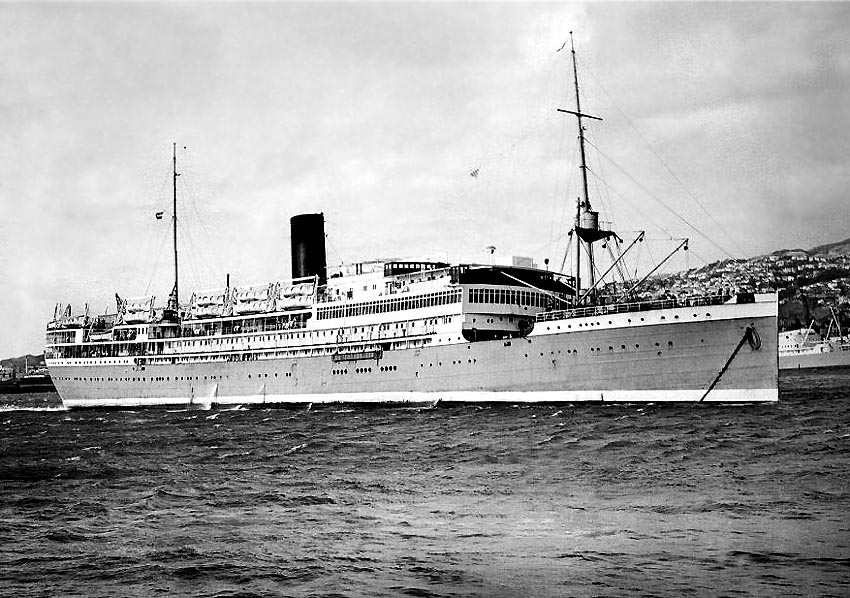
Rotterdam
Lloyd’s MS Sibajak - launched 1928
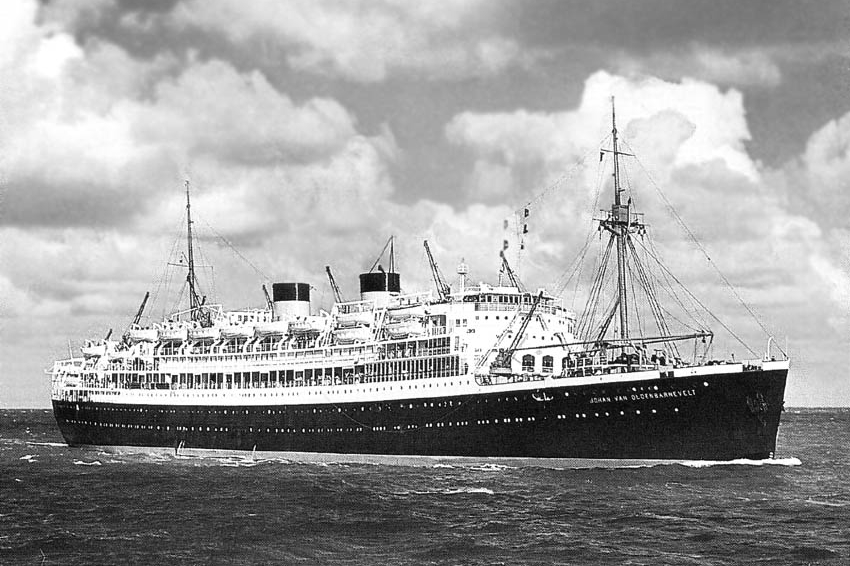
MS Johan van Oldenbarnevelt - launched 1929 - the author sailed on her on a good number of occasions,
but mostly on cruises from Down Under
Then the Netherland Line introduced their
revolutionary and at the time the world’s fastest motor ship in the world
the MS Oranje. She was launched on September 8, 1938 and she commenced sailing
ten months later. Besides her new and modern design, she had a beautifully
raked bow and featured the Netherland Lines new livery. However, far more
noticeable on the exterior was her hull, for it featured her unique
“tumblehome” hull that offered additional interior space. However,
when WW2 broke out she transformed into a fully operating Hospital Ship and was stationed in
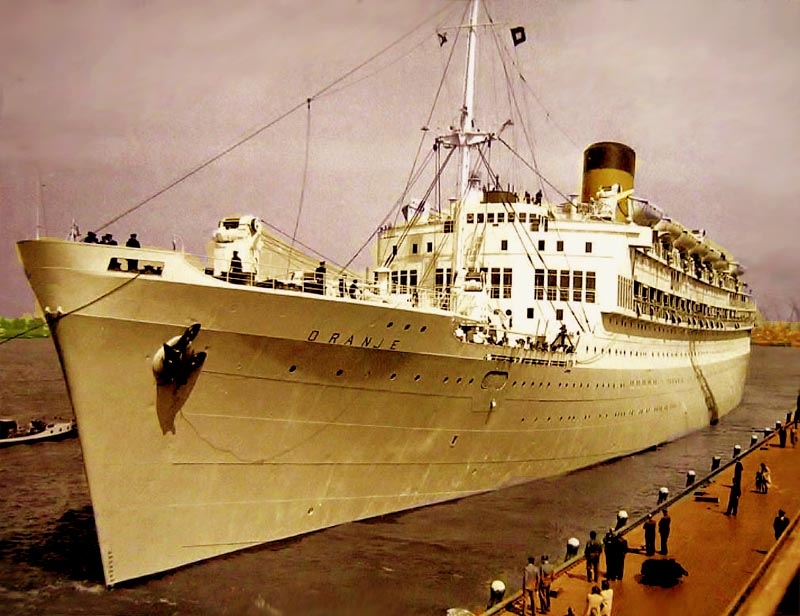
This
photograph clearly reveals the MS Oranje’s
tumblehome hull because of the shore-side crane’s shadow on it
It made sense that the Netherland Lines
biggest competitor before the War and “Rotterdam Lloyd” had already decided to design a ship that would more than match
every level of luxury, comfort, and offers the very best of facilities and
speed by building a new liner. Thus, with plans laid down, an order for a ship
was placed with the “

The
sign reads: “Build (Construction) Number 214, Passenger Ship, Rotterdam
Lloyd
However, as construction was well on the way, but then came the sudden onslaught and bombing of the great Port City of Rotterdam on May 14, 1940 and all construction was very rapidly halted as the air raid continued. The massive bombing attack seemed to hit all the neighbouring yards around the uncompleted Willem Ruys, which at this time was just known as “Yard 214,” and although the damage all around the various yards and throughout the City, But 214 was so fortunate and came out of this untouched and she remained on the slipway throughout the war.

The
Whilst the Germans were in the motion of
invading the
As it now had become part of National Pride to complete the “Rotterdam Lloyd Miracle Ship,” for she defied the hated Nazis. Work continued as men worked with great pride, and considering that the Dutch had used only the very best of materials, the hull only showed signs of slight rust!
A Man of Great Bravery Willem
Ruys
It is important to note that the MS Willem
Ruys was not named after the founder of the
company Mr Willem Ruys Snr, but after his
great-grandson
As work headed toward completion she was
finally heading towards the day of launching, and she had already become known
as; “
The population of
---
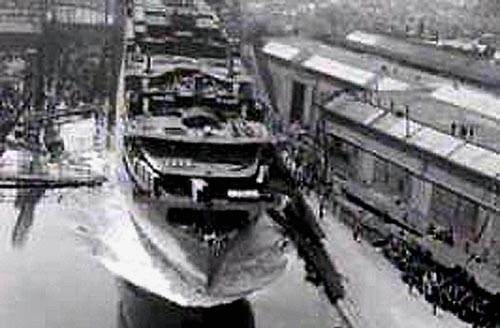
She gently slipped down the slipway, making a
considerable noise and then she entered the water considering she had been on
the stocks since 1939 a long seven years. Having been launched she was taken
under tow and she headed for her Royal de Schelde
Fit-Out berth where she would be completed.
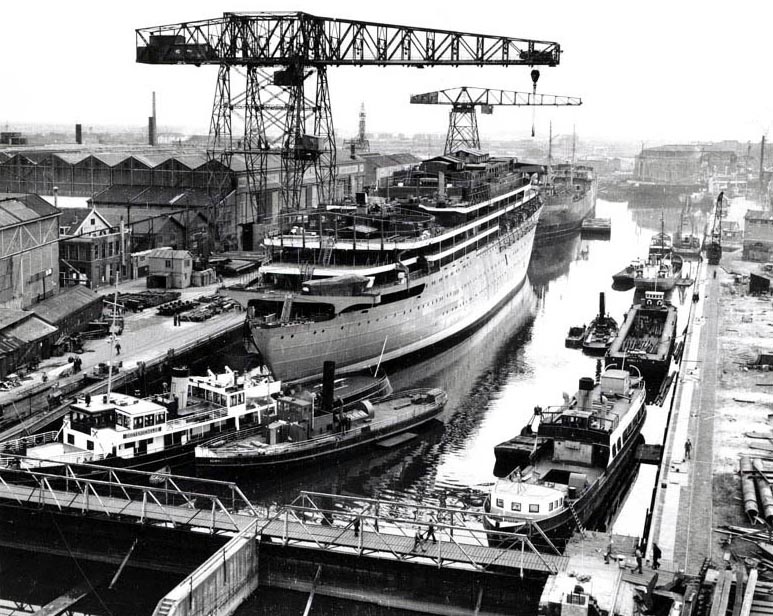
Much
of her upper decks and interior work will be done here
It is at the fit-out be where she is
completed, which included finishing her
superstructure, fitting of her two black squat
funnels and a complete painting of the ship
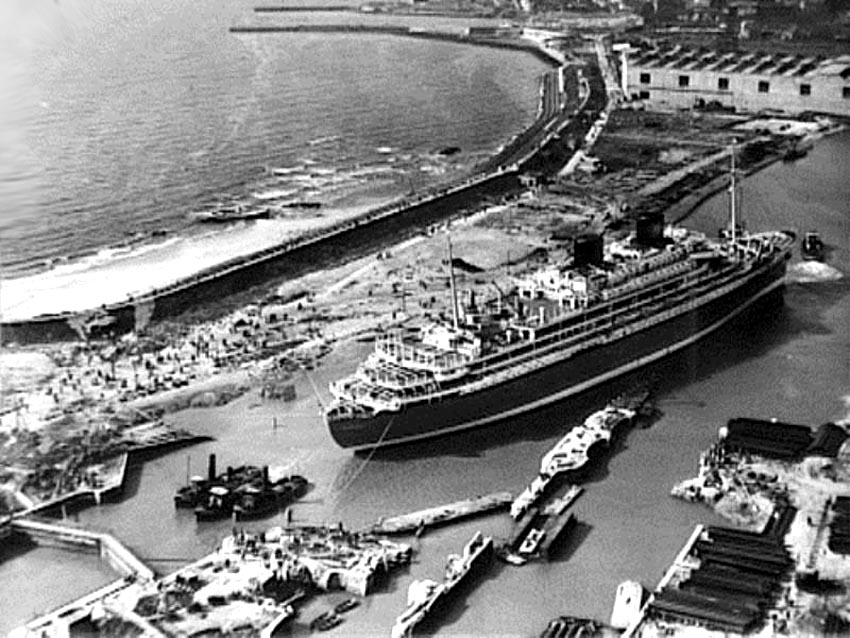
Here
we see her depart the Royal de Schelde Shipyards as
she manoeuvres the Vlissingen Canals to the

The
had her final paint touch-up and has been washed down and will soon return to the
water and head off for her deep sea
trials and she will be delivered to her owners
As a special honour, Queen

Here
we see the
Compared to Oranje her then rival, the
Her Sea Trials:
During her sea trials held between November 15
and 18, 1947 the
With the Willem Ruys being fully certified she was registered in Rotterdam and given the call sign off ‘PIQF,’ and she was delivered to the Royal Rotterdam Lloyd (RRL) at Lloydkade Rotterdam on November 21, giving the company time to make her ready for her maiden voyage and fully man and stock her!
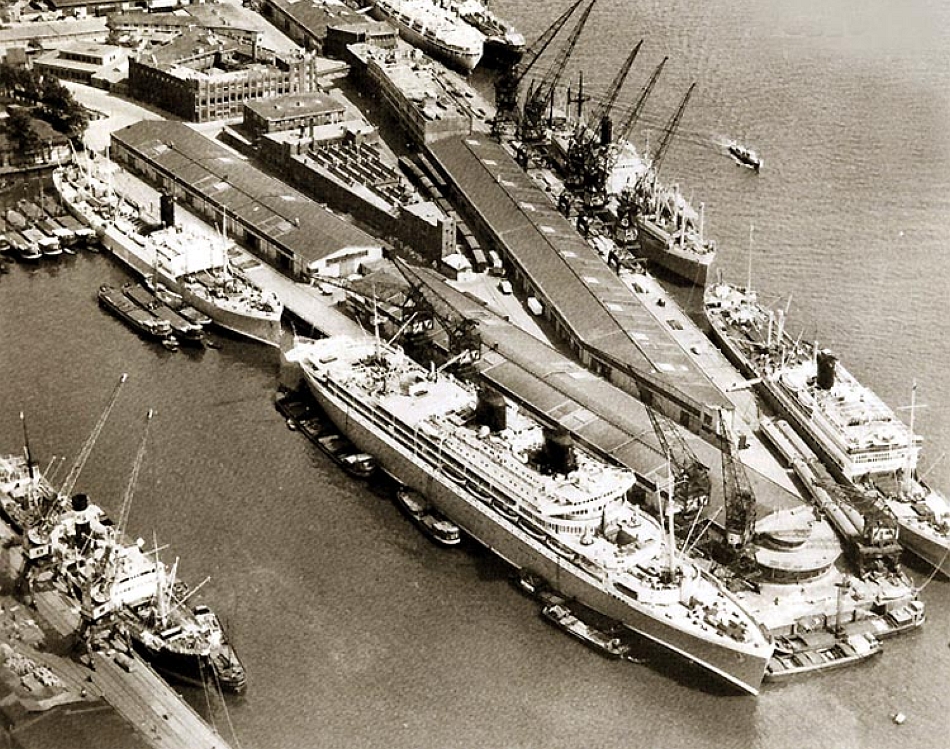
An
aerial view of the
Her Maiden Voyage:
On December 2, 1947, the 21,119 GRT Willem Ruys a spotless liner that was completely ready to sail and head off on her Maiden Voyage, ashore there were 779 eager passengers waiting to board the brand new ship. All who boarded her were amazed by the magnificent surroundings, and that was regardless of the class they booked in, for the facilities in third and even the small fourth class was very high standard indeed, compared to some international companies!
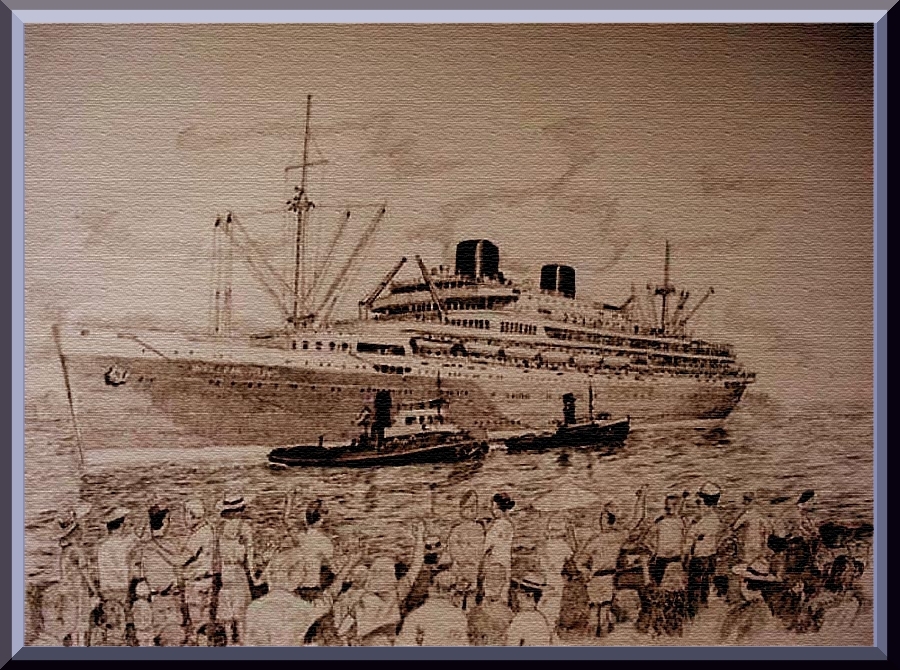
An artist’s impression of the
Her passengers were undoubtedly delighted with her beautiful and comfortable Lounges and facilities as can be seen in the photographs below!
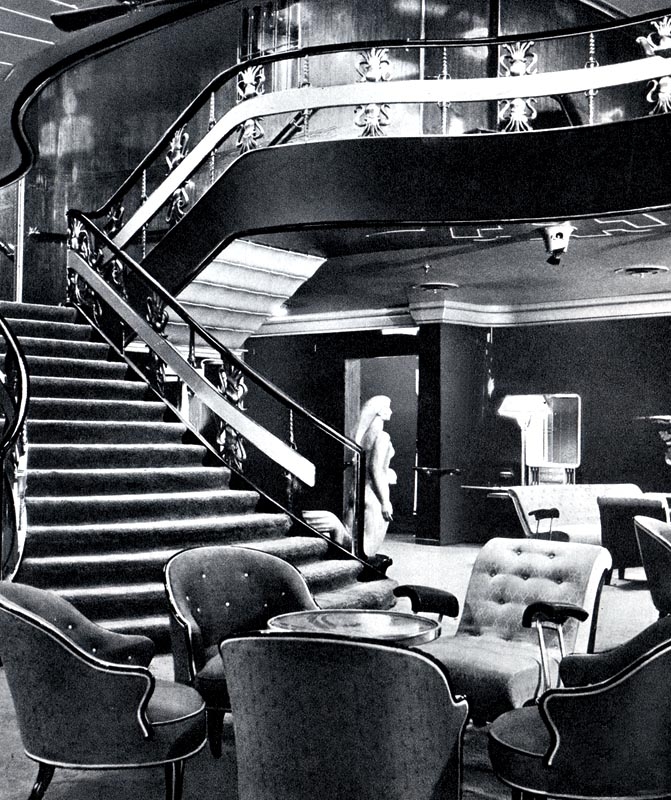
The luxurious two deck high First Class
Social Hall
It is surrounded by a glass enclosed Wintergarden, complete with plants, etc
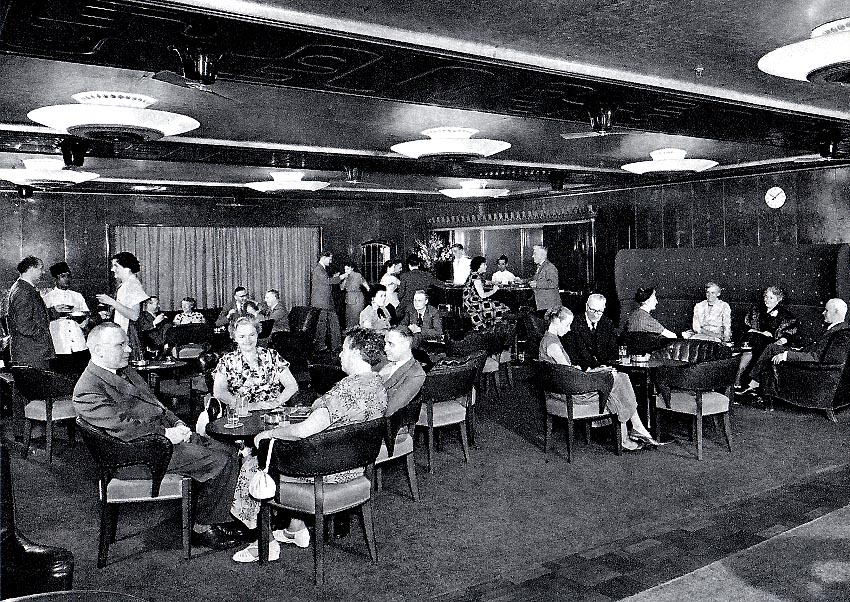
The First class Smoking Room
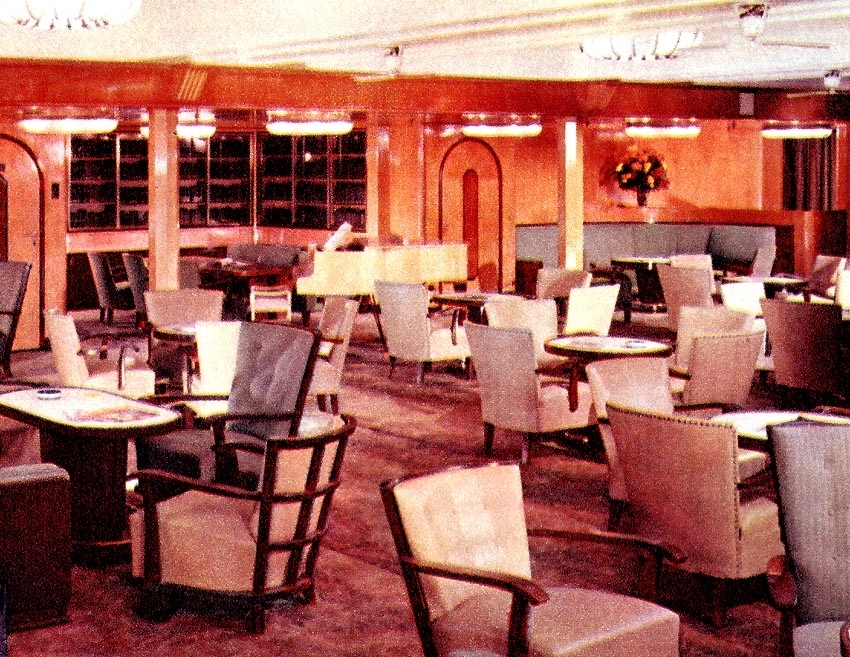
Second Class Social Hall (Main Lounge)
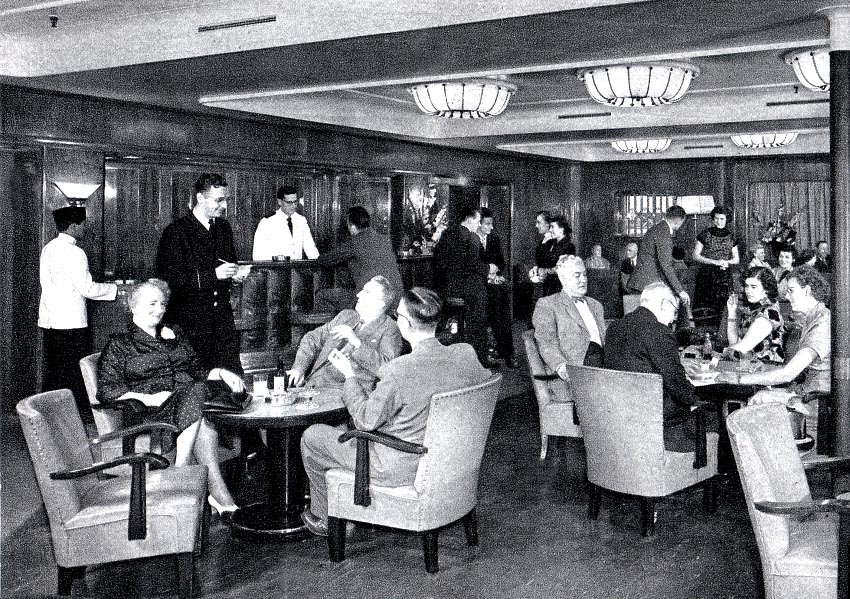
Second Class Smoking Room
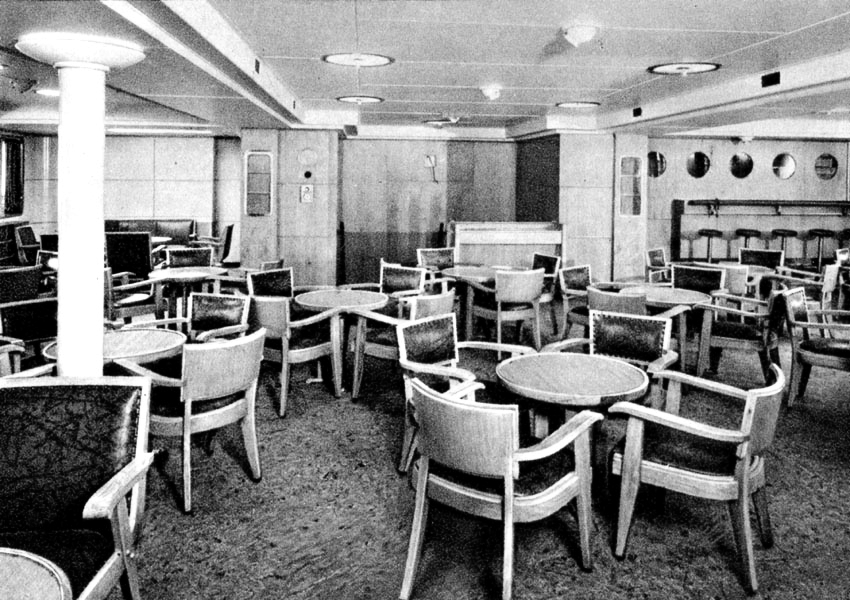
The Third Class Smoking Room features pale timbered walls with marble touches, leather seats, and
plush carpets although somewhat simpler in style, yet most comfortable and complete with a fine bar
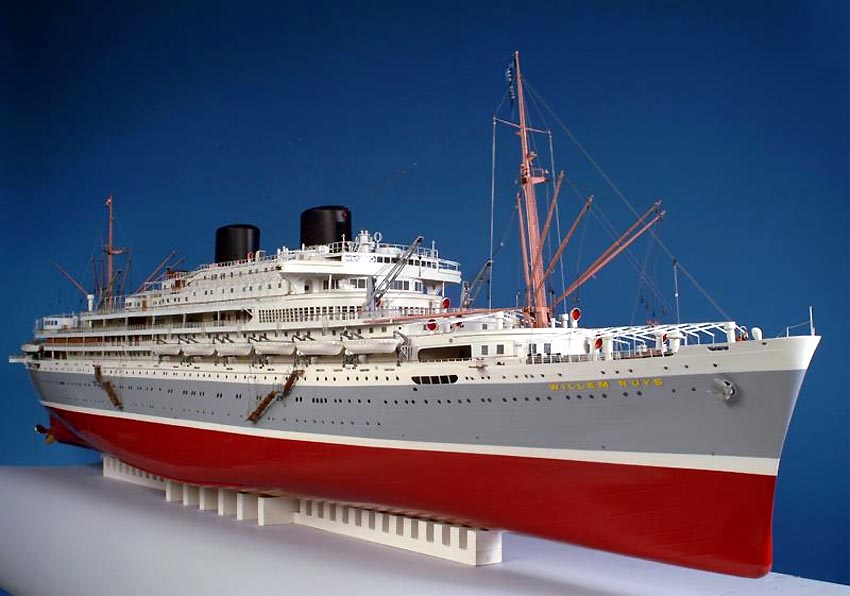
A excellent model built of the MS Willem Ruys
Provided by http://www.maritiemdigitaal.nl
Please Note: Above you will have seen just a few photographs; however there are three comprehensive pages that will take you throughout the ship covering all her classes; 1. as she was built and; 2. After her comprehensive rebuilding and refit in 1958 to mid 1959.
The
The Royal party and the King's ashes left the ship and then boarded the waiting 685-ton Siam Steam Navigation Co, ship, the MS Bhanurangsi and she would sail and take the party to Siam where there was a multitude awaiting them.
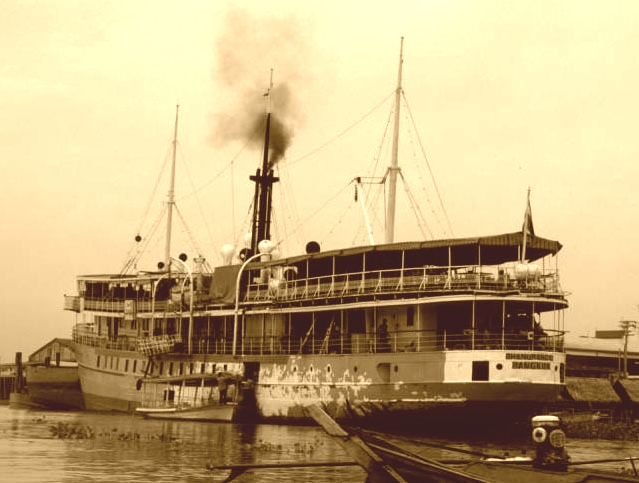
This
is a sepia photo of the MS Bhanurangsi and she served
in the
Although, this photo was taken very much later in her career and at this point she was laid up
Photographer is unknown - Please see Photo Notes at the bottom of the page
When the ship returned to
However at some time during 1949, although the
actual date is unknown, be it prior May or after, but the
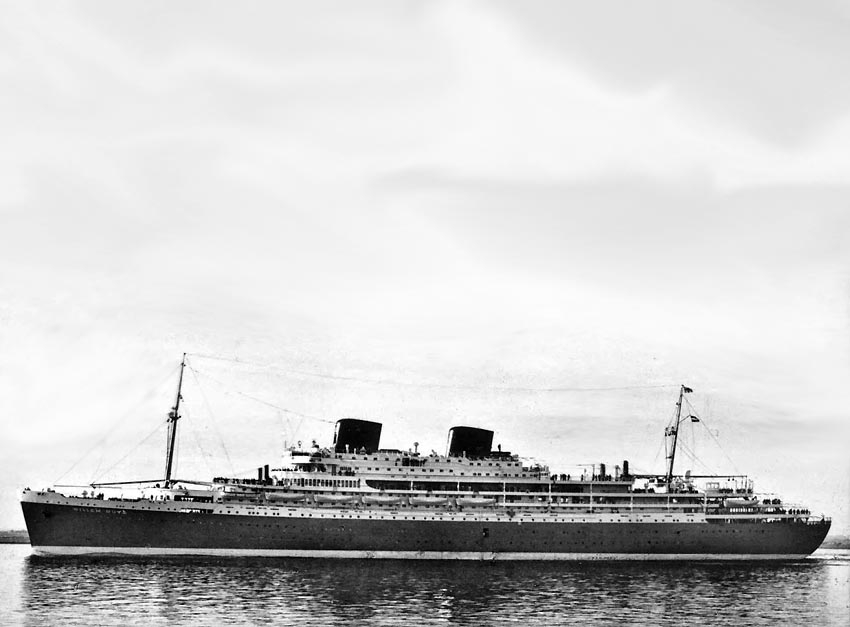
A fine portside view of the MS Willem Ruys
seen prior her rebuilding & refit in 1958 to mid 1959
In December 27, 1952 the
However, after the collision the ship reduced
her speed to just 15.5 knots until the pumping out of the water was under
control at which point speed was increased to 18 knots. Passengers could either
remain on the ship or choose to fly on to
May 1953: Whilst en-route the
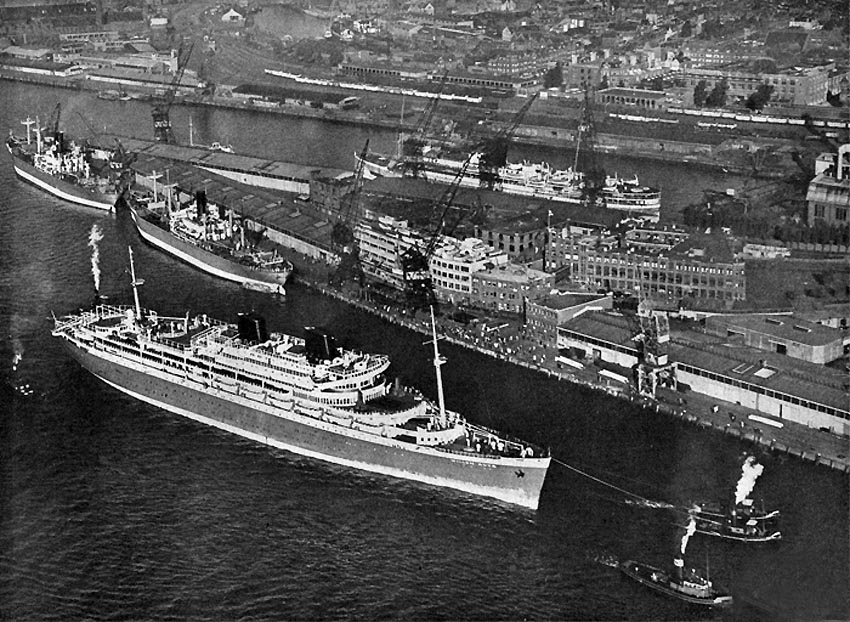
The
Times Are’a ’Changing:
The beautiful and spacious Willem Ruys, became
the most popular liner on the Dutch East Indies service, or as we would call it
these days, the Indonesia service, and with the Willem Ruys, Royal Rotterdam
Lloyd had become a worthy rival to their major opposition, being the Netherland
Lines’ ships the MS Johan van Oldenbarnevelt and MS Oranje. Dutch ships
sailed back and forth to

An
excellent stern view of the
The East Indies, group of islands, having been
a Dutch colony since the 17th.century, gained
its
Her departures from Southampton on March 19,
1958 and
Trans-Atlantic Voyages:
In May 1958 Holland America Line chartered the
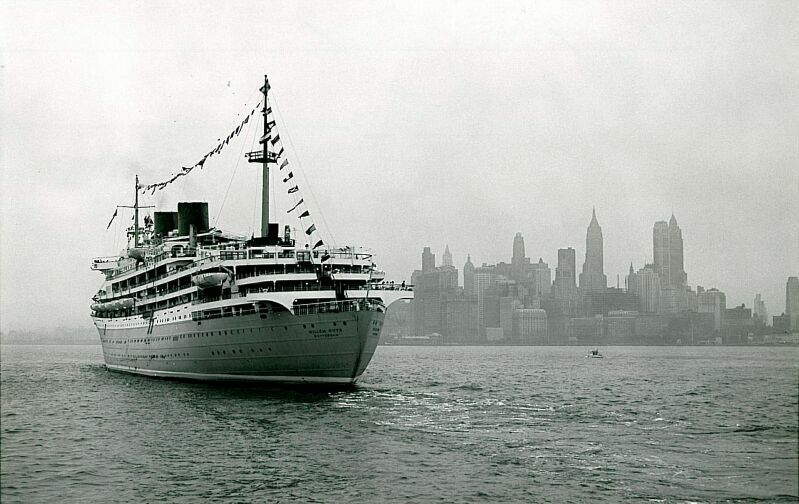
The
MS Willem Ruys arrives at
Photograph by & © Noelle Hollander
1958-59 Rebuild & Refit:
After the four Trans-Atlantic voyages the
The comprehensive work undertaken at the shipyard, her aft hold was removed and in its place brand new 100 Tourist Class cabins were installed, increasing 170 berths. Although originally the ship only had air-conditioning that was functional in the First Class Lounges and Dinning Room, but now she became a fully air-conditioned Liner as well as having Stabilizers fitted. In addition her crew quarters were substantially upgraded.

The
Lounges were comprehensively renovated as were her accommodations upgraded, especially those in Tourist Class. Externally, she was given a delightful new glazed in Tourist Class Wintergarden on both sides of the ship, whilst her funnel had been heightened, giving her a more balanced look. Tourist Class was given a Swimming Pool on the new Deck as her aft decks had been lengthened further aft.

A postcard released by Royal Rotterdam Lloyd (RRL) based on the painting by Dutch
maritime painter
The MS Willem Ruys would now accommodate
275-First Class, and 770-Tourist Class passengers, although there were a good
number of interchangeable cabins and some of these had additional berths
fitted, thus when required, RRL could increase the maximum loading to 1,167,
thus there were an additional 122 berths for
emergencies, or when required. Her new specifications would see her tonnage
increase to 23,114 GRT.
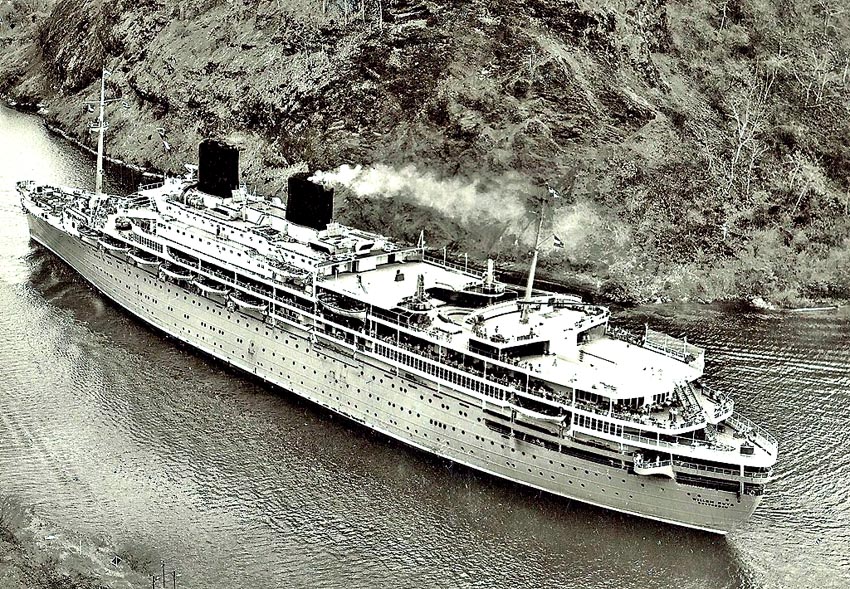
RRL
released this post card
The

The
refitted MS Willem Ruys seen departing
The wonderful almost new looking Liner departed on her new route departing from Rotterdam on March 7, 1959, and she and her two Dutch comrades at sea at that time, the MS Johan van Oldenbarnevelt and the MS Oranje became very popular alternatives to the British liners and together they certainly enjoyed excellent loadings, due to the superb service and sublime cuisine on offer!
The two companies Royal Rotterdam Lloyd and
the Netherland Line collectively operated under the popular banner of; ships of
the “Royal Dutch Mail.” as they together with Greek and Italian
companies operated on the migrant services to Australia, and with the holiday
full fare paying passengers on the return passage, some of these being migrants
visiting their families back home. In February 1963, the 33-year old JVO was
sold to the Greek Line, to become the ill-fated Lakonia, which after a partial
rebuild and a refit took up cruise duties from the UK to the Mediterranean, but
sadly her days with them was very short.
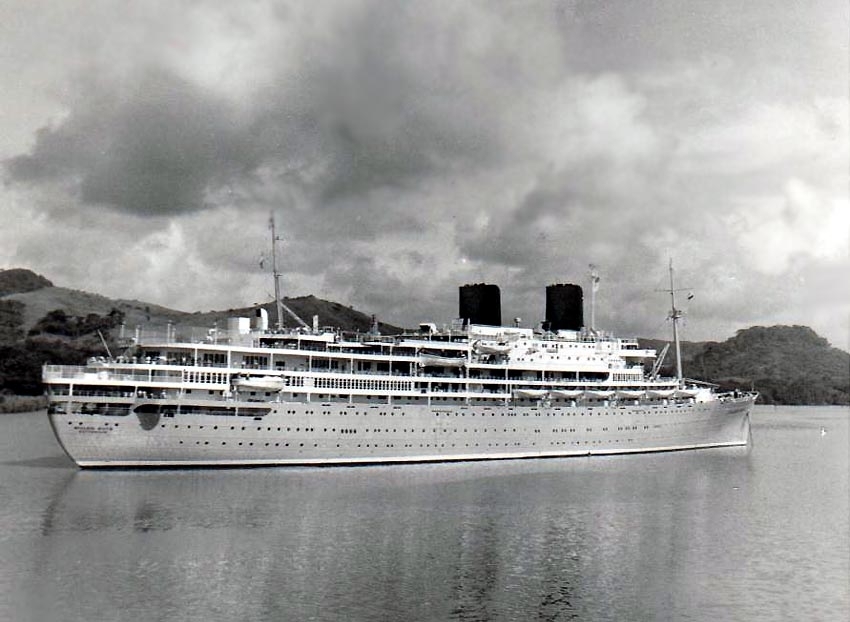
Therefore, sadly towards the end of 1964, due to the poor passenger loadings the superb MS Willem Ruys was laid up in Rotterdam, whilst her running mate the Oranje had had already been laid up in Amsterdam. Both were placed on the market and they were soon obtained by the well-known Italian shipping company, “Flotta Lauro Lines.”
In January 1965, the Willem Ruys was officially handed over and she was officially renamed “Achille Lauro,” whilst the Oranje was renamed “Angelina Lauro” being the names of Mr. Achille Lauro, the company’s owner and Mr. Lauro’s wife Angelina Lauro.
The story of the MS Achille Lauro will be fully told in Part Two, via the LINK at the bottom of this page.
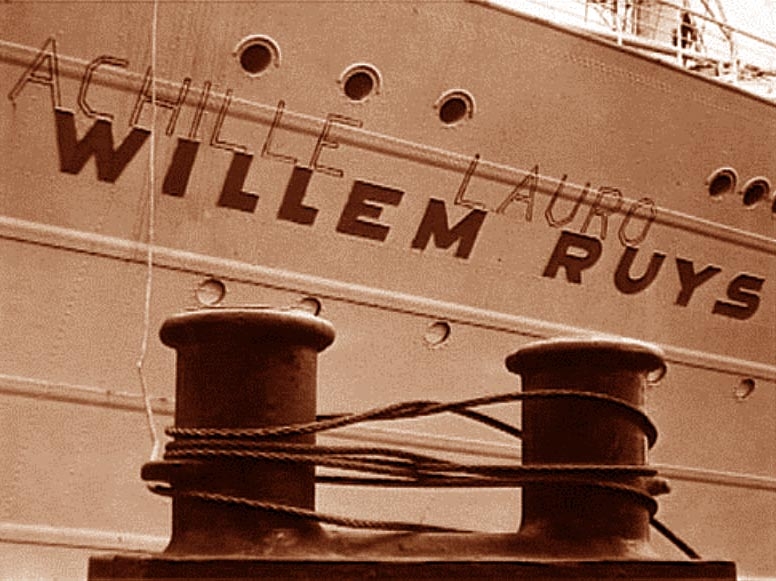
Here we see the bow of the
a stencil was used to add the name ‘
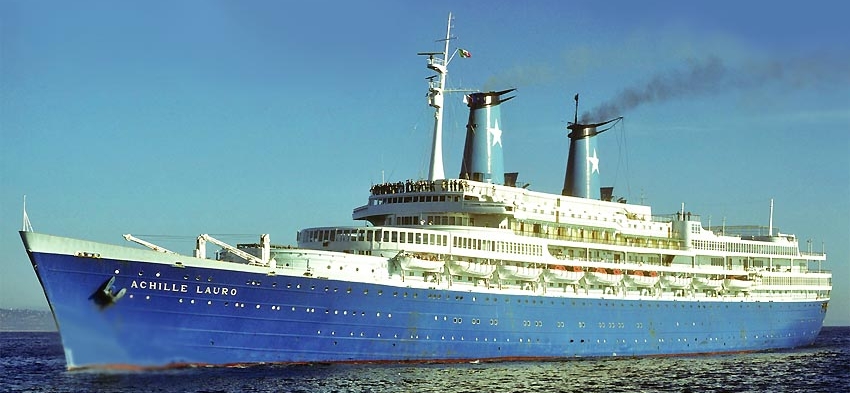
The Flotta Lauro Liner MS Achille Lauro is
seen with her new lengthened sleek bow
funnels together with her new deck
extensions the rebuilding gave the ship a longer and sleek profile
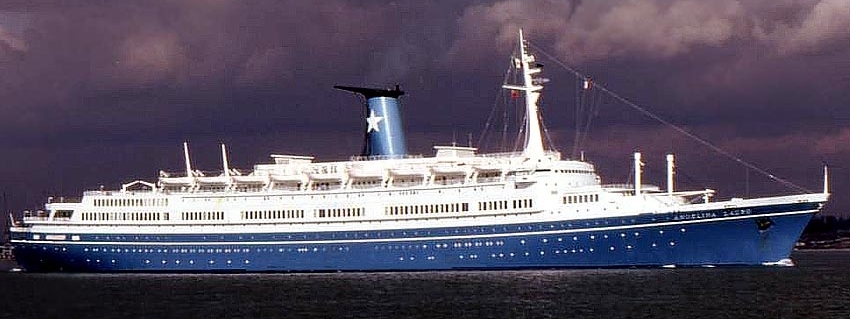
The MS Oranje/Angelina Lauro also received a
massive rebuilding, with a new funnel a
lengthened shapely bow and she became a
superb looking and an ultra modern looking liner
Specifications
as Built
Passenger Capacity:
Passenger Decks: Seven.
Crew: 400
Air-conditioning: Partial
as built - fully air-conditioned as off 1959.
****************************
MS Willem Ruys / MS Achille
Lauro - INDEX:
MS Willem Ruys: Part One.
Photo Page One: First Class.
Page Four: Deck Plans. (Online Soon).
Page Three: Brochures.
Also Read: MS Oranje /
Angelina Lauro - Netherland Line.
This is a 9 page feature, inc. SS
Groote Beer & Waterman - Royal
“Blue Water Liners sailing to the distant
shores.
I watched them come, I watched them go and I watched them
die.”
Return to the ssMaritime MAIN INDEX
ssMaritime.com & ssMaritime.net
Founded
in the early 1990’s - The author is the founder and president
Photographs on ssmaritime and associate pages are by; the author or from the author’s private collection. In addition there are some images that have been provided by Shipping Companies and private photographers or collectors. Credit is given to all contributors. However, there are some photographs provided to me without details regarding the photographer/owner concerned. I hereby invite if owners of these images would be so kind to make them-selves known to me (my email address may be found on www.ssmaritime.com only), in order that due credit may be given.
This notice covers all pages; although, and I have done my best to ensure that all
photographs are duly credited and that this notice is displaced on each page,
that is, when a page is updated!
